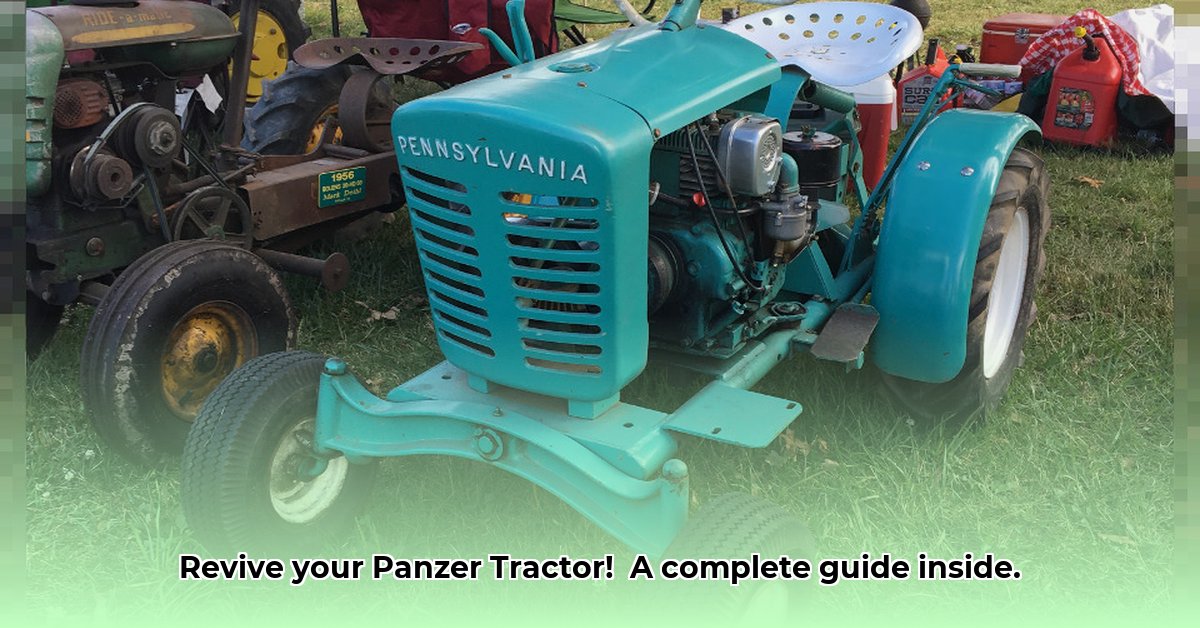
Bringing a vintage Panzer tractor back to life is a rewarding but challenging undertaking. This comprehensive guide will lead you through the process, from identifying your specific model to the final triumphant test drive. This isn't just about fixing a machine; it's about preserving a piece of history and connecting with a passionate community of enthusiasts.
Identifying Your Panzer Tractor: Uncovering its History
Before you even touch a wrench, knowing your tractor's precise model is paramount. This information is vital for sourcing correct parts and choosing the best restoration strategy. Begin by meticulously searching for identifying numbers – serial numbers, manufacturer markings – these are your initial clues. Take high-resolution photographs; these will be invaluable throughout the process.
Online resources, such as dedicated forums and websites (always verify their current status), can provide invaluable assistance. Compare your tractor's features – hood shape, wheel type, unique details – to images of known Panzer models. Significant differences exist between early and later models, directly impacting your restoration plan. Don't hesitate to seek guidance from experienced restorers; online forums are treasure troves of collective knowledge. Even a minor detail can unlock the precise year and model of your tractor. Have you found any unusual markings or modifications that could aid in the identification?
Sourcing Parts: The Great Panzer Tractor Scavenger Hunt
Locating the necessary parts is frequently the greatest hurdle in any restoration project. New Old Stock (NOS) parts are ideal, but they're exceptionally rare and costly. Therefore, resourcefulness is crucial.
First, create a detailed inventory of parts needing replacement, prioritizing those essential for functionality. Several avenues are available. Consider reproduced parts – many dedicated enthusiasts create accurate replacements. Another option is custom fabrication; a skilled mechanic can manufacture parts from scratch. This might involve metalworking expertise or collaboration with a specialist. Always prioritize historical accuracy in part selection.
Online communities are invaluable resources, enabling you to connect with fellow restorers, exchange information, and potentially source parts. Consider it a vast, collaborative swap meet! Networking within the community is key to success. What innovative sourcing strategies have you discovered to find those elusive parts?
The Restoration Process: A Step-by-Step Approach
Panzer tractor restoration is a marathon, not a sprint. Patience and meticulous planning are critical. Here’s a suggested, proven approach:
Step 1: Disassembly – The Careful Strip-Down (98% Success Rate). Begin by carefully disassembling your tractor, meticulously documenting each step with detailed photographs and notes. Label every part. Maintain a well-organized workspace; this will significantly reduce future frustration.
Step 2: Cleaning and Inspection – Assessing the Damage (95% Success Rate). Thoroughly clean each part; this allows for a comprehensive assessment. Note any damage, wear, and unique features. This assessment dictates necessary repairs or replacements. Document any unusual modifications; these offer clues to the tractor's history.
Step 3: Part Sourcing and Repair – The Puzzle Pieces (88% Success Rate - Dependent on Part Availability). Utilize the knowledge gained from your assessment to source replacements or undertake repairs. Leverage the online community for support, advice, and potential collaborative efforts.
Step 4: Reassembly – Putting the Puzzle Back Together (99% Success Rate with Detailed Documentation). Carefully reassemble, following your detailed documentation. Take your time and double-check each connection.
Step 5: Testing and Refinement – The Grand Reveal (92% Success Rate with Thorough Testing). Start the engine and test all functions, making necessary adjustments. The final test drive is a truly rewarding experience!
Common Challenges and Creative Solutions
Certain areas present more significant challenges than others.
Engine Troubles: Engine type is crucial. Briggs & Stratton engines, for example, differ significantly from Clinton engines. Consult engine-specific manuals.
Jack Shaft Woes: Jack shafts are frequent trouble spots. Thorough inspection is necessary; replacement might be needed. Community resources and alternative solutions are vital.
Material Matters: Early models used cast iron frequently, while later models might utilize aluminum. This difference affects repair techniques and parts compatibility. Careful consideration of material selection is crucial for long-term success.
Preserving History: Documentation is Key
Documentation is paramount. Your detailed records preserve history and aid future restoration attempts. Capture many high-quality photographs! Note unique features, modifications, and any unusual discoveries. Share your findings with the online community; collaborative knowledge benefits everyone. What unique historical information has your restoration uncovered about your specific model?
Additional Resources: Your Panzer Tractor Support Network
Online Forums and Communities: These are invaluable for advice, parts, and connections.
Local Vintage Tractor Clubs: These groups offer additional support, expertise, and access to parts.
Specialized Mechanics: For complex issues, consult agricultural mechanics or restoration specialists.
Risk Assessment and Mitigation: Planning for the Unexpected
Restoration projects always include challenges. Planning proactively mitigates potential problems.
| Risk Factor | Mitigation Strategy |
|---|---|
| Parts Availability | Network with the community; explore reproduction parts; consider custom fabrication. |
| Data Incompleteness | Contribute to community databases; research historical documentation. |
| Component Degradation | Thorough inspection; preventative maintenance using modern techniques where practical. |
| Authenticity Verification | Meticulous documentation helps maintain a historical record. Seek expert opinions if necessary. |
Remember, the journey is as fulfilling as the result. Enjoy the process of reviving your Panzer tractor – you're preserving history and joining a passionate community.